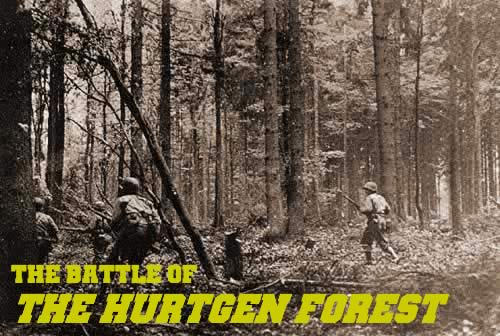
The
28th Infantry Division, known as the "Keystone Division"
by its distinctive red insignia, entered the Hürtgen Forest
on November 2, 1944. By the time they left the "The Green Hell"
eleven days later, all officers in the 28th's rifle companies had
been killed or wounded. The division suffered 6,184 combat casualties,
620 lost to battle fatigue and 738 disabled by trench foot. Nearly
every soldier of the 28th who entered that forest became a battle
casualty.
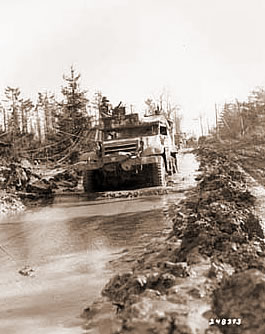 The
Hürtgen Forest, a dark, densely wooded area along the western
border of Germany, gave the Germans excellent defensive positions,
the thick cover of the woods concealing their trenches, bunkers,
blockhouses and booby traps. Trails were mined --- one three-mile
stretch had mines every four feet. Without any distinguishing landmarks,
it was easy for soldiers to get confused and lost. Companies lining
up for attacks missed their appointed positions, left gaps in the
line, and were quickly outflanked by the enemy in seesaw firefights.
The raw autumn weather, leading to the coldest winter in Northern
Europe in a century, was cold and wet. Rain filled trenches and
foxholes. The few trails and firebreaks in the area turned into
rivers of mud. Most soldiers gave up on trying to keep either clean
or dry. Many caught cold or developed infections, and the number
of cases of painful trench foot skyrocketed. The fighting was brutal
and increasingly senseless. At least one company commander broke
down and was relieved. The
Hürtgen Forest, a dark, densely wooded area along the western
border of Germany, gave the Germans excellent defensive positions,
the thick cover of the woods concealing their trenches, bunkers,
blockhouses and booby traps. Trails were mined --- one three-mile
stretch had mines every four feet. Without any distinguishing landmarks,
it was easy for soldiers to get confused and lost. Companies lining
up for attacks missed their appointed positions, left gaps in the
line, and were quickly outflanked by the enemy in seesaw firefights.
The raw autumn weather, leading to the coldest winter in Northern
Europe in a century, was cold and wet. Rain filled trenches and
foxholes. The few trails and firebreaks in the area turned into
rivers of mud. Most soldiers gave up on trying to keep either clean
or dry. Many caught cold or developed infections, and the number
of cases of painful trench foot skyrocketed. The fighting was brutal
and increasingly senseless. At least one company commander broke
down and was relieved.
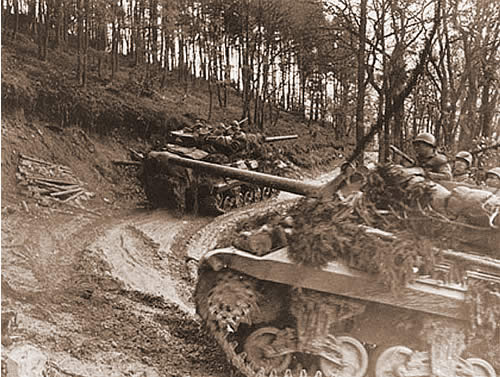
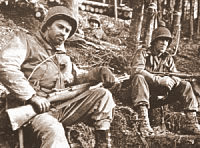 The
28th Infantry Division was virtually destroyed in less than two
week's of combat - as hadthe two divisions that preceded it into
the forest in September and October. Subsequent divisions didn't
fare much better and by the time the Americans finally secured the
Hürtgen Forest in February 1945, it had become the scene of
one of the longest and costliest battles in US military history.
In spite -- or because -- of that, it's been overshadowed by the
Bulge. Even the official Army account of WWII gives it only cursory
mention. Survivors and historians have long debated whether the
Hürtgen Forest was even a worthy objective. The GIs sustained
over 24,000 killed, wounded or missing. The Germans suffered 27,000
casualties. The
28th Infantry Division was virtually destroyed in less than two
week's of combat - as hadthe two divisions that preceded it into
the forest in September and October. Subsequent divisions didn't
fare much better and by the time the Americans finally secured the
Hürtgen Forest in February 1945, it had become the scene of
one of the longest and costliest battles in US military history.
In spite -- or because -- of that, it's been overshadowed by the
Bulge. Even the official Army account of WWII gives it only cursory
mention. Survivors and historians have long debated whether the
Hürtgen Forest was even a worthy objective. The GIs sustained
over 24,000 killed, wounded or missing. The Germans suffered 27,000
casualties.
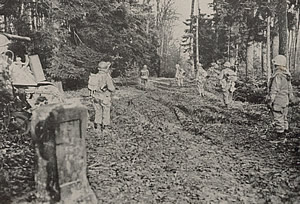 When
pulled from the front line, the 28th, now nicknamed "The Bloody
Bucket" because its red keystone had become symbolic of the
massive amount of blood it had shed, was sent to another heavily
wooded sector along the German border to recover from its ordeal.
After a couple quiet weeks, all hell broke loose in this other forest
--- the Ardennes Forest. The 28th Infantry Division was right in
the middle of a massive surprise attack of 500,000 German soldiers
making their last desperate bid for victory. When
pulled from the front line, the 28th, now nicknamed "The Bloody
Bucket" because its red keystone had become symbolic of the
massive amount of blood it had shed, was sent to another heavily
wooded sector along the German border to recover from its ordeal.
After a couple quiet weeks, all hell broke loose in this other forest
--- the Ardennes Forest. The 28th Infantry Division was right in
the middle of a massive surprise attack of 500,000 German soldiers
making their last desperate bid for victory.
"Between
Life and Death..."
The
Battle of the Hürtgen Forest
Evolution of the Diorama
M3A1 Halftrack
Dodge Ambulance and Beep
Willys
Jeep, 2.5 Ton Cargo Truck, Trailers
The Figures
References
|












